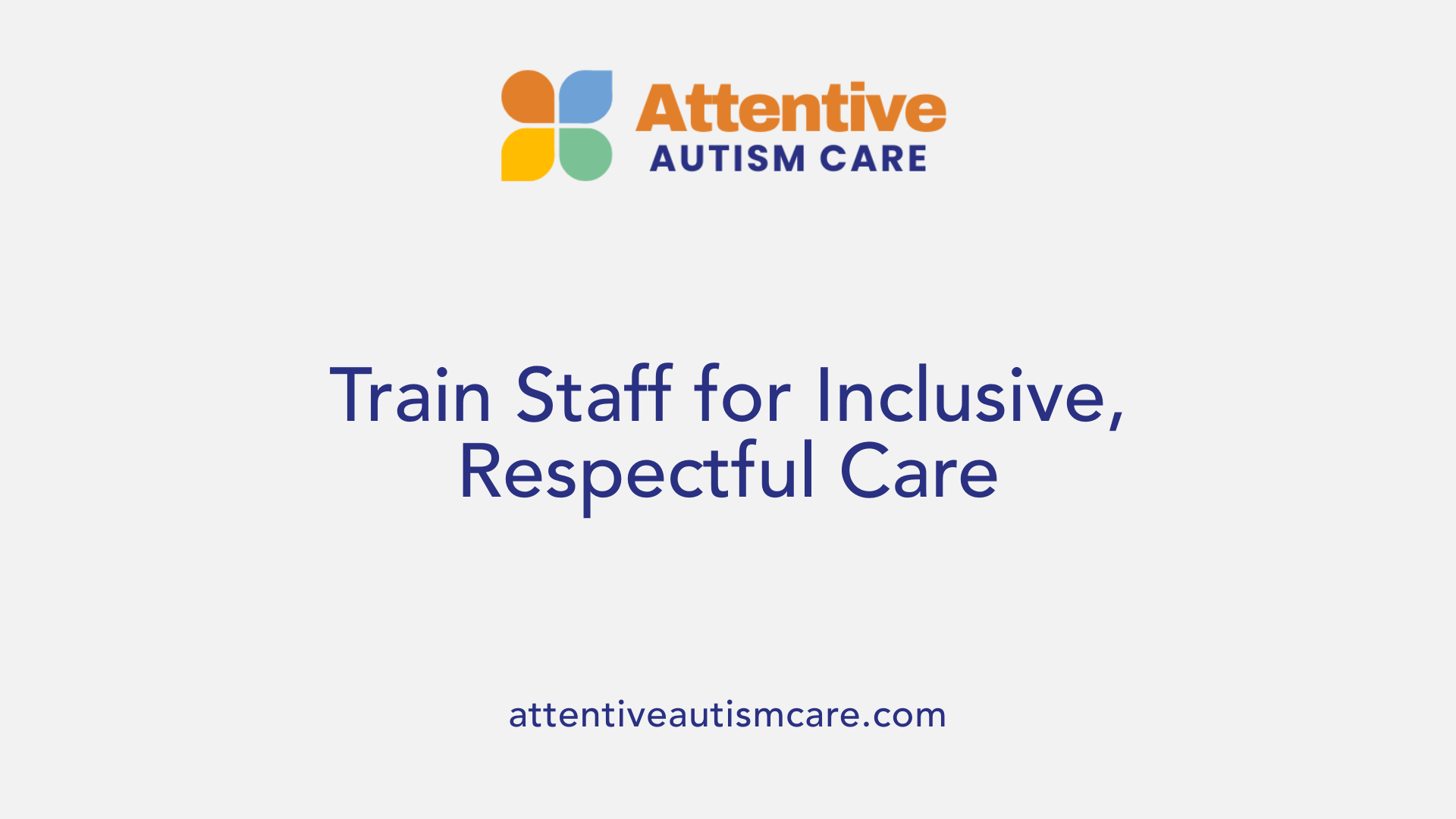Supporting Autistic Individuals Through Medical Procedures
Transforming Healthcare Experiences for Autistic Patients

A Compassionate Approach to Medical Care for Autism Spectrum Disorders
Providing effective, respectful, and individualized medical care to autistic individuals requires an understanding of their unique needs and challenges. From sensory sensitivities to communication differences, healthcare providers must adopt specialized strategies, environmental modifications, and evidence-based interventions. This article explores comprehensive approaches, resources, and systemic improvements designed to foster autism-friendly healthcare environments and ensure positive medical experiences for individuals across the lifespan.
Creating Autism-Friendly Healthcare Environments and Accommodations

How can healthcare providers create autism-friendly environments and accommodations?
Designing healthcare spaces that cater to autistic individuals requires thoughtful modifications to reduce sensory-overload and promote comfort. Sensory modifications such as soft lighting, noise reduction measures, and calming elements like weighted blankets or sensory fidget toys can significantly decrease stress levels during visits. These adjustments help create a more relaxing environment that minimizes overwhelming stimuli.
In addition, utilizing visual supports like picture schedules and social stories can improve communication and help patients understand procedures better. These tools provide predictability and clarify expectations, easing worries and fostering cooperation.
Environmental changes also include establishing quiet waiting areas, designated calming rooms, and providing soothing music or low lighting in treatment rooms. Flexible scheduling options, such as early morning appointments or longer time slots, accommodate individual pacing and needs, reducing feelings of rush or crowd-related distress.
A crucial aspect is staff training—educating healthcare professionals on autism awareness, sensory sensitivities, and responsive care techniques. When staff understand how to communicate clearly and adapt procedures, they can provide more respectful, inclusive care.
Engaging families in feedback and involving them in planning ensure that accommodations evolve based on real needs. Continually refining protocols through a quality improvement process helps develop a healthcare environment that is accessible, supportive, and respectful of autistic patients.
Overall, by combining sensory-friendly modifications, visual supports, environmental adjustments, staff education, and family involvement, healthcare providers can make a tangible difference in the medical experiences of autistic individuals, fostering positive and less stressful visits.
Supporting Autistic Individuals Through Medical Procedures

How does positioning for comfort help autistic children during medical procedures?
Positioning for comfort involves holding the child in a safe and secure manner, which can significantly reduce stress during medical procedures like blood draws. Proper positioning helps the child feel more secure and less overwhelmed by the environment, making it easier for healthcare providers to perform necessary tasks.
Why should caregivers consult healthcare providers about comfort positions?
Collaborating with healthcare professionals ensures that the chosen positions are safe and effective for the child's specific needs. These discussions can lead to personalized strategies that maximize comfort, reduce anxiety, and support cooperation during procedures.
How can distractions like toys and activities improve the experience?
Bringing a child's favorite toy, music, or activity can serve as effective distraction tools. These items help shift the child's attention away from the procedure, reducing fear and resistance. Using familiar items also provides a sense of security and familiarity.
What role does preparation play in easing medical visits?
Preparing with the child's medical history and planning with healthcare teams enables a more manageable experience. Pre-visit planning might include creating visual schedules or social stories to familiarize the child with what to expect, decreasing unpredictability and anxiety.
How does honest and age-appropriate communication affect cooperation?
Using clear, straightforward, and developmentally suitable language helps address fears directly. Honest communication fosters trust, reduces confusion, and encourages cooperation, resulting in less stressful procedures for the child.
What behavioral and sensory strategies support successful healthcare interactions?
Implementation of sensory-friendly modifications such as quiet waiting areas, sensory tools, and visual supports can make environments more tolerable. Behavioral strategies like positive reinforcement and systematic exposure help increase tolerance for medical procedures over time.
Why is family involvement important?
Engaging families in familiarization activities, such as role-playing or visiting the clinic beforehand, helps children feel more comfortable. Family input provides insights into individual preferences and sensory needs, enabling tailored approaches for successful healthcare experiences.
What resources and support options are available for individuals with autism during medical procedures?
Resources include specialized healthcare initiatives that focus on environmental adjustments, staff training, and the use of visual supports such as social stories and hospital passports. These facilitate communication and understanding.
Support options extend to behavioral tools like the Vanderbilt Kennedy Center's toolkit for blood draws, which offers parents and providers evidence-based strategies. Child life services, the presence of familiar support persons, and pre-visit familiarization activities help alleviate anxiety. Additionally, telehealth options and training programs for healthcare providers, such as those developed by Autism Speaks and the Autism Treatment Network, improve overall care quality.
By combining these tools and approaches, healthcare providers and families can create a supportive environment that promotes cooperation, reduces distress, and ensures safe, positive medical experiences for autistic individuals.
Interventions and Therapies to Improve Medical Experiences
What interventions and therapies are recommended to support autistic individuals in medical settings?
Supporting autistic individuals during medical visits involves a blend of personalized strategies, evidence-based therapies, and environmental adjustments. Behavioral interventions like Applied Behavior Analysis (ABA) and other applied techniques play a crucial role in increasing tolerance for medical procedures, decreasing anxiety, and reducing challenging behaviors. These approaches often include functional assessment, systematic exposure, and reinforcement of positive responses.
Speech and occupational therapies are integral to improving communication skills and sensory regulation. Speech therapy can enhance language abilities, enabling patients to express needs or fears clearly, while occupational therapy can address sensory sensitivities, helping individuals better manage hypersensitivities related to light, noise, and touch.
Educational methods such as TEACCH utilize visual supports and structured routines, providing predictability that reduces fear and confusion. Visual schedules and social stories effectively prepare patients for what to expect, making procedures like blood draws or hospital visits less intimidating.
Psychological approaches, especially Cognitive Behavioral Therapy (CBT), are valuable for managing associated anxiety and mental health challenges. CBT helps patients develop coping skills, reframe fears, and regain a sense of control.
Adjustments within healthcare environments—such as creating calm, sensory-friendly spaces, reducing wait times, and involving family members—further ease the experience. Specific accommodations like noise-canceling headphones, low-light areas, and the option to hold or interact with medical tools support sensory needs.
Pharmacological treatment may be necessary to manage co-occurring conditions like anxiety, hyperactivity, or sleep issues, under professional supervision. Importantly, biomedical interventions aimed directly at altering core autism traits lack sufficient evidence and are generally not recommended.
Altogether, adopting an individualized, person-centered care plan that respects each person’s preferences, needs, and sensitivities is essential. Collaboration among healthcare professionals, families, and support services ensures that interventions are both appropriate and effective, fostering positive healthcare experiences that uphold dignity, safety, and independence.
| Therapy Type | Main Focus | Supporting Details |
|---|---|---|
| Behavioral Therapy | Reduce anxiety, increase cooperation | ABA, systematic exposure, reinforcement techniques |
| Speech Therapy | Improve communication | Language development, alternative communication strategies |
| Occupational Therapy | Sensory regulation, daily skills | Sensory integration, coping with hypersensitivities |
| Educational Strategies | Enhance understanding and predictability | Visual supports, social stories, structured routines |
| Psychological Therapy | Mental health management | CBT, anxiety and stress reduction techniques |
| Environmental Adjustments | Sensory environment, comfort | Quiet rooms, low lighting, sensory tools, tailored procedural modifications |
| Pharmacological Treatments | Co-occurring conditions | Medication for anxiety, hyperactivity, sleep issues, under medical supervision |
By implementing these interventions within a supportive, flexible healthcare setting, clinicians can greatly improve the health care journeys of autistic individuals, ensuring they receive respectful and effective care.
Training for Healthcare Providers and Caregivers
What training and resources are available for healthcare providers and caregivers to better support autistic patients?
Supporting autistic individuals through healthcare requires specialized knowledge, ongoing education, and access to tailored resources. Several programs and materials have been developed to empower both healthcare providers and caregivers.
One prominent example is the certification programs offered by the International Board of Credentialing and Continuing Education Standards (IBCCES). These include the Certified Autism Specialist (CAS) and Advanced Certified Autism Specialist (ACAS) courses. These certifications focus on evidence-based practices, improving communication, managing sensory sensitivities, early identification, and ethical care tailored to autism. They are designed to guide professionals across diverse roles, from medical practitioners to behavioral therapists.
The Centers for Disease Control and Prevention (CDC) provides a wealth of educational resources aimed at promoting early diagnosis and intervention. Their materials include developmental screening tools and guides that support professionals and families in recognizing early signs of autism, encouraging timely support and better health outcomes.
Online training opportunities from organizations like the Autism Society are available for caregivers, educators, and health workers. These courses cover autism basics, health equity, behavioral strategies, and workplace inclusion. They are frequently developed with input from autism experts and often offer continuing education credits to ensure professionals stay updated.
For adult care, Harvard Medical School’s 'Clinical Care for Autistic Adults' course prepares healthcare providers to deliver personalized, equitable services through modules addressing communication strategies, sensory considerations, and managing co-occurring conditions.
Ongoing education is crucial because autism is a lifelong condition, and best practices evolve. Features of these training programs include modules on sensory sensitivities, communication techniques, behavioral interventions, and inclusive care practices.
Ultimately, enhancing provider skills and caregiver knowledge leads to higher quality care, reduced anxiety for patients, and more positive healthcare experiences. The combination of formal certification programs, online courses, and practical resources form a comprehensive framework for supporting autistic individuals throughout their lifespan.
| Program / Resource | Focus Area | Description | Audience |
|---|---|---|---|
| IBCCES Certifications | Autism support | Specialized training in evidence-based practices and ethical care | Healthcare professionals, educators, therapists |
| CDC Educational Materials | Early diagnosis | Developmental screening tools, autism awareness resources | Healthcare providers, families |
| Autism Society Online Courses | General autism support | Autism fundamentals, inclusion strategies, behavior management | Caregivers, educators, health workers |
| Harvard Medical Courses | Adult autism care | Personalized, equitable healthcare practices for adults | Health professionals |
Supporting the autism community with updated training and practical tools is essential for delivering compassionate, effective healthcare tailored to individual needs.
Transitions to Adult Healthcare Services
How can transitions to adult healthcare services be supported for autistic individuals?
Supporting the move from pediatric to adult healthcare for autistic individuals begins early, ideally around age 12. Early planning helps prepare youth for upcoming changes and ensures they receive seamless ongoing care.
Utilizing transition checklists and resources, such as the Vanderbilt Kennedy Center’s 'Health Care for Adults with Developmental Disabilities' toolkit and Autism Speaks’ 'Healthcare Transition Roadmap,' provides a structured approach. These resources guide families and healthcare providers through the necessary steps, including medical assessments, skill development, and fostering independence.
Effective collaboration between pediatric and adult healthcare providers is vital for a smooth transition. This can involve 'warm handoffs,' shared appointments, and information sharing, ensuring both teams are aligned on the individual's needs and preferences. Encouraging shared decision-making empowers autistic youth, giving them confidence and skills to manage their health independently.
Preparation tools like social stories, visual schedules, and assessment instruments tailored to transition readiness help familiarize autistic individuals with new healthcare environments. Telehealth options can also ease access and reduce anxiety during the transitional phase.
Addressing systemic barriers, such as healthcare provider training gaps and limited access to specialized care, is critical. Advocacy for policies that support continuous, person-centered care, like supported decision-making laws, plays an essential role.
Engaging caregivers actively supports independence while respecting autonomy. Their insights help tailor transition plans, ensuring they address unique needs and preferences.
Continuous monitoring and community-supported research, led by agencies like the CDC, help identify gaps in services and develop tailored solutions. This ongoing process fosters an inclusive, adaptable healthcare system that meets the evolving needs of autistic adults.
Policy and Systemic Improvements for Healthcare Equity
What are the policy and systemic issues affecting healthcare access for autistic individuals, and how can services be improved?
Autistic individuals often encounter barriers within the healthcare system due to various policy and systemic shortcomings. One major challenge is inadequate insurance coverage, with gaps in Medicaid and private insurance plans that limit access to comprehensive autism-related treatments and supports.
Funding is another concern, as many community-based and specialized services lack sufficient financial support, leading to long waiting times and limited availability. Workforce shortages trained specifically in autism care further hinder timely and effective treatment, affecting outcomes across the lifespan.
Legislation like the Autism CARES Act, Medicaid expansion under the Affordable Care Act, and laws such as IDEA and the Mental Health Parity Act aim to address these issues but often face hurdles in implementation and funding. Structural barriers include the absence of seamless, family-centered care coordination and a focus on early detection and intervention, which are crucial for better long-term outcomes.
Improving access and quality of care requires a combination of policy measures. Strengthening insurance protections to cover a broad range of services ensures affordability. Increasing funding for home-based and community supports can make services more accessible. Expanding training programs for healthcare providers enhances their ability to deliver autism-specific care confidently.
Implementing integrated, multidisciplinary care models promotes collaboration across health, education, and social sectors, making services more responsive to individual needs. Promoting policies that foster inclusion in education, employment, and community life further enhances equitable access and social participation.
Efforts to address these systemic gaps are essential to reduce disparities and ensure that all autistic individuals receive the comprehensive, respectful, and effective healthcare they deserve.
Moving Toward Equitable, Compassionate Care
Optimizing healthcare for autistic individuals involves comprehensive environmental modifications, individualized care plans, behavioral and sensory interventions, extensive training for providers, and systemic policy reforms. Emphasizing person-centered, family-inclusive, and evidence-based approaches can significantly improve medical experiences, reduce stress, and promote health equity across all age groups. Ongoing commitment to innovation, collaboration, and advocacy is essential to build a healthcare system that truly supports the diverse needs of the autistic community, ensuring respectful and effective medical care for every individual.
References
- Easing Anxiety During Medical Procedures: Positioning for Comfort
- Autism-Friendly Healthcare: A Narrative Review of the Literature
- Medical Encounters for Youth With Autism Spectrum Disorder
- Accessing comprehensive health care - Autism Speaks
- Addressing Barriers to Healthcare: Medical Procedure Toleration
- Treatment and Intervention for Autism Spectrum Disorder - CDC
- Creating Sensory-Friendly Health Care Environments for Autistic ...




































































































